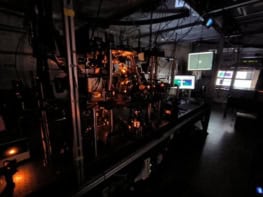
Beams of light polarized into spirals have been used by scientists in the UK to create intricate patterns on the surface of metals. This is the first time that these “logarithmic spirals” have been produced in the lab, and the researchers believe that they could provide valuable insights into the angular momentum of light. On a more practical note, they could also be used in imaging and data-storage applications.
The polarization of light describes the relationship between the direction the light is travelling and the direction in which the light’s electric field is oscillating. Linear polarization involves the electric field oscillating in a fixed direction that is at right angles to propagation, whereas circular polarization involves the direction of the electric field rotating around the direction of propagation. The polarization can also be much more complicated. In a radially polarized beam, for example, the electric field at any point in the beam points in a line from the centre to the edge. In an azimuthally polarized beam, the electric field is at right angles to these lines, thereby forming concentric circles.
In the new research, Walter Perrie of the University of Liverpool and colleagues led by Jinglie Ouyang passed a linearly polarized laser beam through a specialized type of nano-structured plate that outputs either a radially polarized vector beam or, if it is rotated by 90°, an azimuthally polarized beam. “People normally set them up to produce one or the other,” explains Perrie. Instead, the team set the plate at an intermediate angle to produce a superposition of the two states. The resulting beam is a logarithmic spiral that was first described by Descartes and is similar to the shape of spiral galaxies. By altering the orientation of the plate, the researchers could control the proportions of radially and azimuthally polarized light in the beam, thereby altering the curvature and handedness of the spiral. These properties were predicted by Franco Gori of Università degli Studi Roma Tre in 2001, but have never been observed before.
Tiny grooves
The researchers then focused their beams of light onto a steel surface. By a process called surface laser plasmon structuring, the electric fields in the beam created tiny grooves in the surface of the metal. The grooves are at right angles to the local fields, and therefore purely radial fields create azimuthal grooves, purely azimuthal fields produce radial grooves, and logarithmic spiral fields create logarithmic spiral grooves. The team believes that this ability to produce grooves with spacing comparable to the wavelength of light could be useful for encoding information.
The team has also used the process to study the physics of light by looking at what happens when orbital angular momentum is added to the beam of light. This involves having the wavefront of the light twist around the axis of propagation like a fusilli spiral. Under normal circumstances, the intensity of a radially or azimuthally polarized beam is zero at its centre, so the centre of the plasmon-structured surface will not be marked. However, the addition of orbital angular momentum resulted in light intensity at the centre of the beam, and the periodic structures were more blurred at the centre of the spiral. A clear rotation of the vector field was also observed. The team says that this suggests the presence of spin angular momentum, which is carried by circularly polarized light. Indeed, the observation suggests that some of the orbital angular momentum of the beam has been converted to spin angular momentum. “We’ve got to think seriously about what that really means,” says Perrie.
The beauty of photons
“I think this is a significant experimental step to elaborate the beauty of photons that follow a series of twisted patterns in space,” says nanoplasmonics expert Nicholas Fang of the Massachusetts Institute of Technology. “I feel this experimental observation might enable novel applications in high-speed optical cross-sectioning, optical tomography and manipulation with better precisions.”
The research is described in Optics Express.



